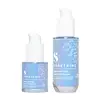What's inside
What's inside
 Key Ingredients
Key Ingredients

 Benefits
Benefits

 Concerns
Concerns

No concerns
 Ingredients Side-by-side
Ingredients Side-by-side

Water
Skin ConditioningPentylene Glycol
Skin ConditioningGlycerin
HumectantMethylpropanediol
SolventCopper Tripeptide-1
Skin Conditioning1,2-Hexanediol
Skin ConditioningPolyacrylate Crosspolymer-6
Emulsion StabilisingHydrolyzed Ulva Lactuca Extract
Skin ConditioningAllantoin
Skin ConditioningPanthenol
Skin ConditioningXanthan Gum
EmulsifyingAcetyl Hexapeptide-1
Skin ConditioningNicotiana Benthamiana Hexapeptide-40 Sh-Polypeptide-47
Skin ConditioningResveratrol
AntioxidantSodium Hyaluronate
HumectantEthylhexylglycerin
Skin ConditioningHydroxyethylcellulose
Emulsion StabilisingSynthetic Wax
AbrasiveCaprylyl Glycol
EmollientSodium Benzoate
MaskingPotassium Sorbate
PreservativePhenoxyethanol
PreservativeC20-40 Pareth-10
EmulsifyingHydroxyethyl Behenamidopropyl Dimonium Chloride
Polyquaternium-67
Water, Pentylene Glycol, Glycerin, Methylpropanediol, Copper Tripeptide-1, 1,2-Hexanediol, Polyacrylate Crosspolymer-6, Hydrolyzed Ulva Lactuca Extract, Allantoin, Panthenol, Xanthan Gum, Acetyl Hexapeptide-1, Nicotiana Benthamiana Hexapeptide-40 Sh-Polypeptide-47, Resveratrol, Sodium Hyaluronate, Ethylhexylglycerin, Hydroxyethylcellulose, Synthetic Wax, Caprylyl Glycol, Sodium Benzoate, Potassium Sorbate, Phenoxyethanol, C20-40 Pareth-10, Hydroxyethyl Behenamidopropyl Dimonium Chloride, Polyquaternium-67
Water
Skin ConditioningAmmonium Polyacryloyldimethyl Taurate
Emulsion StabilisingButylene Glycol
HumectantHydrogenated Lecithin
EmulsifyingPotassium Methoxysalicylate
BleachingPhenoxyethanol
PreservativeDipentaerythrityl Hexa C5-9 Acid Esters
Skin ConditioningNeopentyl Glycol Diheptanoate
EmollientPolymethylsilsesquioxane
Polyglyceryl-4 Caprate
EmulsifyingAroma
Benzotriazolyl Dodecyl P-Cresol
UV AbsorberBHT
AntioxidantDisodium EDTA
Ethylhexylglycerin
Skin ConditioningMalus Domestica Fruit Cell Culture Extract
Skin ConditioningXanthan Gum
EmulsifyingGlycerin
HumectantCaprylyl Glycol
EmollientLecithin
EmollientDiamond Powder
AbrasiveGlyceryl Caprylate
EmollientLactic Acid/Glycolic Acid Copolymer
Skin ConditioningPhenylpropanol
MaskingChlorella Vulgaris Extract
Skin ConditioningPolyvinyl Alcohol
Heptapeptide-15 Palmitate
Skin ConditioningWater, Ammonium Polyacryloyldimethyl Taurate, Butylene Glycol, Hydrogenated Lecithin, Potassium Methoxysalicylate, Phenoxyethanol, Dipentaerythrityl Hexa C5-9 Acid Esters, Neopentyl Glycol Diheptanoate, Polymethylsilsesquioxane, Polyglyceryl-4 Caprate, Aroma, Benzotriazolyl Dodecyl P-Cresol, BHT, Disodium EDTA, Ethylhexylglycerin, Malus Domestica Fruit Cell Culture Extract, Xanthan Gum, Glycerin, Caprylyl Glycol, Lecithin, Diamond Powder, Glyceryl Caprylate, Lactic Acid/Glycolic Acid Copolymer, Phenylpropanol, Chlorella Vulgaris Extract, Polyvinyl Alcohol, Heptapeptide-15 Palmitate
 Reviews
Reviews

Ingredients Explained
These ingredients are found in both products.
Ingredients higher up in an ingredient list are typically present in a larger amount.
Caprylyl Glycol is a humectant and emollient, meaning it attracts and preserves moisture.
It is a common ingredient in many products, especially those designed to hydrate skin. The primary benefits are retaining moisture, skin softening, and promoting a healthy skin barrier.
Though Caprylyl Glycol is an alcohol derived from fatty acids, it is not the kind that can dry out skin.
This ingredient is also used as a preservative to extend the life of products. It has slight antimicrobial properties.
Learn more about Caprylyl GlycolEthylhexylglycerin (we can't pronounce this either) is commonly used as a preservative and skin softener. It is derived from glyceryl.
You might see Ethylhexylglycerin often paired with other preservatives such as phenoxyethanol. Ethylhexylglycerin has been found to increase the effectiveness of these other preservatives.
Glycerin is already naturally found in your skin. It helps moisturize and protect your skin.
A study from 2016 found glycerin to be more effective as a humectant than AHAs and hyaluronic acid.
As a humectant, it helps the skin stay hydrated by pulling moisture to your skin. The low molecular weight of glycerin allows it to pull moisture into the deeper layers of your skin.
Hydrated skin improves your skin barrier; Your skin barrier helps protect against irritants and bacteria.
Glycerin has also been found to have antimicrobial and antiviral properties. Due to these properties, glycerin is often used in wound and burn treatments.
In cosmetics, glycerin is usually derived from plants such as soybean or palm. However, it can also be sourced from animals, such as tallow or animal fat.
This ingredient is organic, colorless, odorless, and non-toxic.
Glycerin is the name for this ingredient in American English. British English uses Glycerol/Glycerine.
Learn more about GlycerinPhenoxyethanol is a preservative that has germicide, antimicrobial, and aromatic properties. Studies show that phenoxyethanol can prevent microbial growth. By itself, it has a scent that is similar to that of a rose.
It's often used in formulations along with Caprylyl Glycol to preserve the shelf life of products.
Water. It's the most common cosmetic ingredient of all. You'll usually see it at the top of ingredient lists, meaning that it makes up the largest part of the product.
So why is it so popular? Water most often acts as a solvent - this means that it helps dissolve other ingredients into the formulation.
You'll also recognize water as that liquid we all need to stay alive. If you see this, drink a glass of water. Stay hydrated!
Learn more about WaterXanthan gum is used as a stabilizer and thickener within cosmetic products. It helps give products a sticky, thick feeling - preventing them from being too runny.
On the technical side of things, xanthan gum is a polysaccharide - a combination consisting of multiple sugar molecules bonded together.
Xanthan gum is a pretty common and great ingredient. It is a natural, non-toxic, non-irritating ingredient that is also commonly used in food products.
Learn more about Xanthan Gum